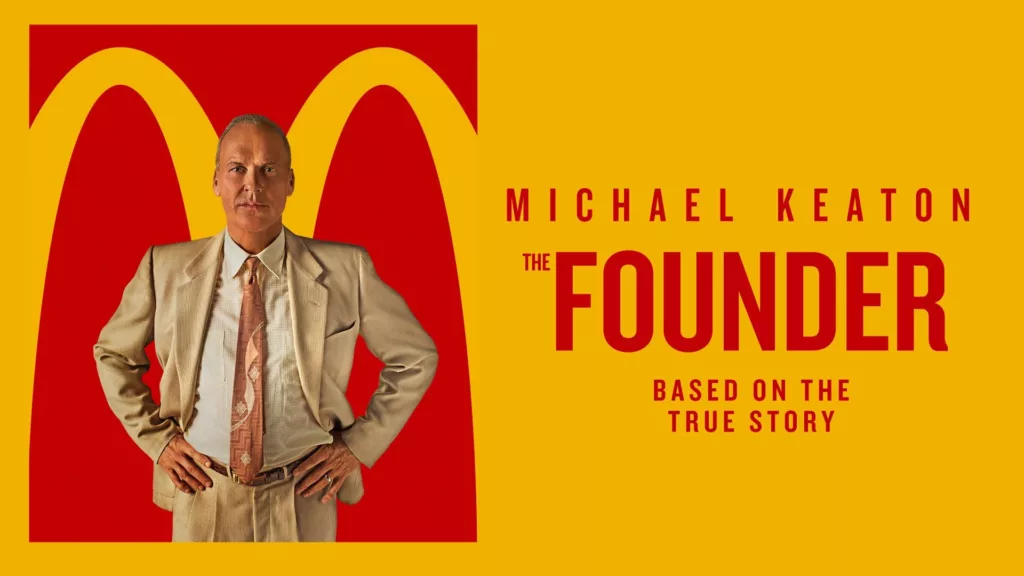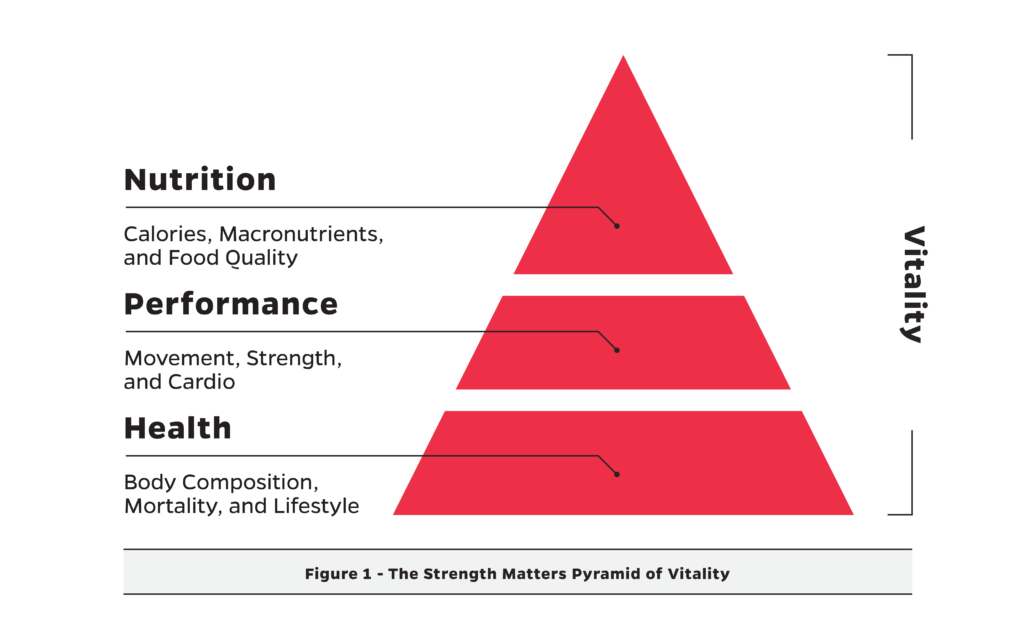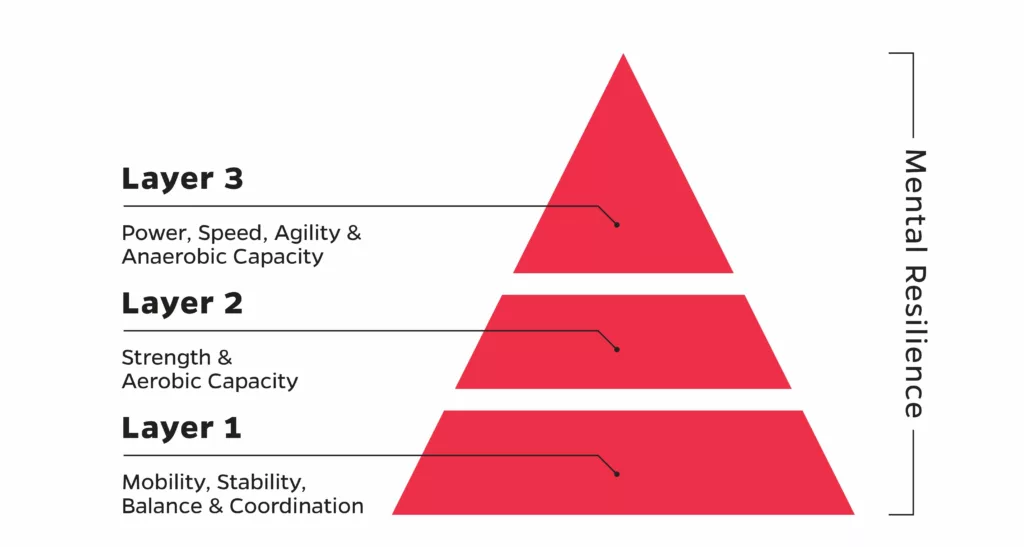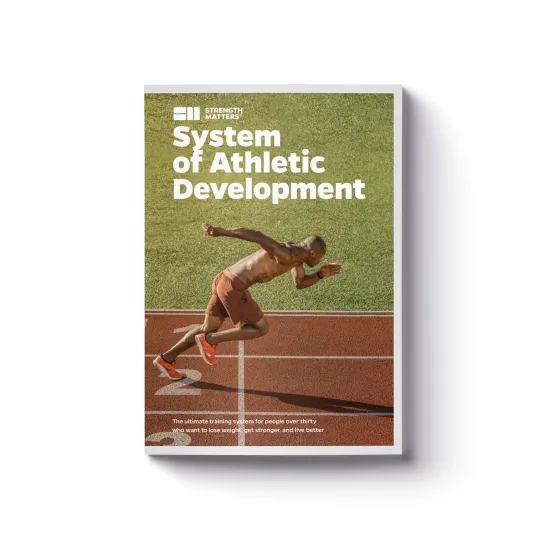Welcome to the Strength Matters Performance Pyramid: The Ultimate Athlete Development System. This comprehensive, innovative system revolutionizes how teams, fitness businesses, and trainers collaborate and work together.
Designed with efficiency and flexibility in mind, the Strength Matters Performance Pyramid streamlines athletic development and optimizes performance, saving significant time and resources in the process.
Our approach transcends traditional training methods, incorporating a progressive structure that adapts to the diverse needs of athletes at all stages. As you navigate this system, you’ll discover the freedom to tailor the program to individual athletes’ goals and abilities, fostering an environment of personal growth and team success.
We’ve created the blueprint—now, it’s your turn to build your athletic development dynasty.
Table of Contents
The Backstory of the Performance Pyramid
During the fall of 2016, I went through a profound change in how I perceived health and fitness. I discovered, at the tender age of just 33, I was no longer athletic. It hit me over the head like a sledgehammer. It was the first realization in my entire life that I was getting old. And it hurt.
It was during this time that I started to develop the concept of the ten components of complete athleticism. You see, I was on a quest to regain my athleticism, and I had to define athleticism as having tangible components so that I could correct them. It’s just how my brain works. Blame the computer science geek in me.
During this time of self-discovery, a new film appeared on my radar. I missed it at the cinema, but it was now readily available on NetFlix. It was called The Founder, and it starred Michael Keaton.

It was the story of how McDonald’s came to be. Being an avid business geek, I was curious to see what I could learn from one of the biggest companies in the world. Irrespective of what I think of the food they serve, I wanted to know the origins and the methods they used, and how they came to be.
McDonald’s is renowned for having one of the best franchise business models in the world, and people accredit their success to the systems they employed to allow anybody—and we mean anybody—to open their own McDonald’s restaurant. So I dug out the popcorn, put my feet up, and started to watch the movie.
Three Things I Learned from The Founder Movie That Applies to Athlete Development
Prior to watching the movie, little did I know that it would be the movie that had the single biggest impact on my beliefs about athlete development. The movie couldn’t be anything further from being healthy.
Yet, I thoroughly enjoyed it, and I left with three key takeaways:
- I hate McDonald’s even more. (Sorry, McDonald’s.)
- Product refinement and quality is king.
- Simplistic systems that people can follow and apply are the key to long-term success.
I won’t leave any spoilers here if you haven’t seen the film, but I will say that the way Ray Kroc hijacked the business from the McDonald brothers was scandalous. That’s why I hate McDonald’s even more.
However, the McDonald brothers’ endless quest in the initial years to refine the product stood out to me. It wasn’t just about a great-tasting burger.
It was also about the speed and efficiency at which it was delivered. It was about giving the customers what they wanted – great fast food (in that era).
You can compare this mindset to the world of health and fitness. People don’t just want a great workout or to know how long you’ve spent crafting it.
They want a great workout, an expert training plan, and fast results. It’s the result of living in a Netflix society.
The film made me realize that we needed to refine our system of delivering the product to clients. We thought we had a great product; however, it wasn’t delivered with the same consistency that you get with a McDonald’s burger.
There was no defined process, and our delivery was often slow. Our system certainly wasn’t as consistent as a production line of hamburgers from McDonald’s was.
Now if you combine this never-ending pursuit of product refinement with Ray Crock’s vision of system development, you have the makings of a process and system that can be easily replicated and implemented—an extremely potent mix for business success.
Ray Kroc’s vision of systems was the catalyst for McDonald’s success. It was about implementing a proven system that guaranteed the franchisee’s success. It wasn’t enough that the product was great.
The key ingredient was Ray Kroc’s system of implementation. It taught franchisees how to guarantee their success.
Strength Matters didn’t have a proven process, and it certainly didn’t have a system of athletic development. I thought we did, but we didn’t. It was all in my head.
There was nothing written down. The coaches weren’t implementing a system either. They were applying what they knew in their heads, too. It was educated guesswork.
There was no structure, formula, or guidelines for how we created training plans, and without structure, chaos is born. And chaos leads to haphazard results.
The Founder gave me the kick-start I needed. While developing the ten components of complete athleticism, I realized that I needed to create a process and a system—a system that would lead to great results for our clients.
A process that made it easy for our coaches to follow and implement, and most importantly, a system that had a solid basis of scientific and real-world, practical application.
Why You Need a System of Athletic Development
Systems and processes play a significant role in building a business. They serve as the company’s essential building blocks and support.
It’s an absolute necessity for long-term success. I’ll never know why I had never considered this for athletic development, but it became glaringly obvious.
With a model of athletic development, our principles, philosophy, and ability to implement became much clearer and easier to understand.
It allowed all of our coaches to be on the same page, and it ensured that the clients we trained understood how and why we do what we do.
A tried and trusted system of athletic development allows us to consider the efficiency and accuracy of the whole process. If there’s a chink in the armor, we can quickly identify it, re-evaluate it, and improve upon it.
Systems simply aid the process of an athlete’s development. That’s the bottom line. Coaches need each client to grow as an individual, but it’s also a business.
Clients need to know the systems so that they know exactly where they sit on the athletic scale, and they can monitor and see their progress.
Systems lead to enhanced performance by helping us implement strategic planning, creation, and operation in everything we do.
Creating the Strength Matters Pyramid of Performance was one of the best things I ever did for my own training, the training of clients, and the Strength Matters business. It allowed us to meet and exceed the expectations of our clients.
Knowing the strengths and weaknesses of our system allows us to conveniently monitor our client’s progress, and it leaves us better aware of any improvements that need to be made.
We’ve seen a significant improvement in our coaches’ performance and their creativity. This has led to a new avenue of personal engagement between the coaches and their clients.
In a nutshell, the Strength Matters Pyramid of Performance has:
- Significantly improved client results
- Given us better consistency in results
- Made change easier to accomplish when things aren’t working
- Made training new coaches easier
- Allowed us, as coaches, to focus on what we do best – getting results
- Provided a framework of operation
I can’t overestimate the power of the system I’m about to present to you.
An Overview of the Strength Matters Performance System
Before I share the Strength Matters Performance Pyramid, you need to understand our model of fitness. It’s the forty-thousand-foot overview.

As coaches, we now know that the most important thing on someone’s fitness journey is health. Without good health, you have nothing. Poor health impacts long-term athletic development.
We prioritize it above everything else.
Once we establish good health, we can focus on the quality of movement, and with good movement comes fitness. Fitness is a very broad term. It means different things to different people.
Some people see fitness as a mechanism to deal with everyday life. Others see it as a route to sporting glory. Either way, it’s ambiguous. It’s why we’ve used it. There’s so much more to this, but it’s our starting point.
You’ll also see that nutrition comes last. There’s a reason for that, but we’ll talk about that another time.
But let’s focus on where the performance pyramid comes into play.
The Strength Matters Performance Pyramid
If you haven’t yet read the blog about the ten components of complete athleticism, I highly recommend doing so now. It will help put this whole section into perspective.
We believe in balanced athletic fitness here at Strength Matters. We believe everyone is an athlete, an everyday athlete. We believe elite athletes and everyday athletes should be ready to handle anything that life throws their way.
The Strength Matters Performance Pyramid is a complete pathway for all levels and abilities to follow on their journey to elite fitness.
We believe that complete athleticism is made up of ten components:
- Mobility
- Stability
- Balance and Coordination
- Strength
- Aerobic Capacity
- Power
- Speed
- Agility
- Anaerobic Capacity
- Mental Resilience
They’re all equally as important; however, some precede others to enable a full expression of athleticism.

As you can see, there are three layers.
Layer 1 is the foundation of movement.
Layer 2 is basic strength and aerobic capacity.
Layer 3 is the advanced sexy stuff that everyone wants to default to. But more often than not, people don’t have the pre-requisite movement, strength, or aerobic capacity to do so effectively.
This ultimately leads to athletes not achieving their true maximum physical potential, or worse yet, it can lead to injury.
The Strength Matters Performance Pyramid is our guiding beacon. For each of the components, we have assessments and standards that we want people to adhere to.
Our initial process for assessment is:
- We assess Health.
- We assess Layer 1.
- We assess Layer 2.1.
Not everyone will receive all the assessments. You have to earn the right.
We have broken Layers 2 and 3 into two subsections – 2.1, 2.2, 3.1, and 3.2. It’s like a computer game. You have to successfully complete each level to reach the next one.
If an athlete successfully passes Layer 1 and Layer 2.1, we then open up Layer 2.2. This layer includes slightly more advanced strength and aerobic capacity assessments.
This is essentially the gateway to elite athleticism.
The standards we have set here need to be adhered to before we allow anyone to progress to Layer 3. No exceptions.
We know from experience that if these strength standards or aerobic standards cannot be met, true maximum physical potential will never be reached, and the risk of injury is higher than it needs to be.
We believe less than 5% of the world’s population will ever need to venture into the world of Layer 3. Layer 3 is the world of elite athleticism.
Most humans are not elite athletes, and their lifestyles are not conducive to elite training, even though they think they are.
If everyday people never reach Layer 3, in our eyes, that’s okay. Layer 2 and 2.2 are good healthy places to be. You will have the pre-requisite strength and aerobic capacity to take on anything in life and perform well.
Layer 3 is for those who are ready to start pushing their athletic capabilities to the next level, and that takes a certain kind of individual.
The Performance Pyramid is our proven process of success that we all adhere to at Strength Matters. We have a system of assessments, and from the assessments, we can pinpoint an individual’s weakness with incredible accuracy.
It has completely revolutionized how we train people. It has significantly improved the speed at which we assess, and it has significantly improved how we program for people, allowing for a more individualized solution that leads to better, faster results.
I honestly don’t know how we lived for so long without it.
Final Thoughts
As we bring this exploration of the Strength Matters Performance Pyramid to a close, we want to reinforce the unique value this system offers – an interconnected framework that transcends traditional training approaches, making way for seamless collaboration between teams, fitness businesses, and trainers.
This ultimate athletic development system isn’t just about identifying and tackling weaknesses – it’s about a profound transformation in how we approach athletic growth, fostering personal improvement while facilitating team success.
In a sea of standard training methods, the Performance Pyramid offers the flexibility and efficiency that today’s dynamic sporting landscape demands.
You might be wondering about the specifics, like our standards and assessment procedures. It’s worth noting that the intricacies of this system can’t be captured in a few words. We’ll cover those in more depth in future articles, I promise
On the surface, the Performance Pyramid may seem compact, but dive deeper and you’ll discover a meticulously designed process that’s as expansive as it is effective.
Committing to the complete process, from the initial health assessments to the complexities of Layer 3.2, is an immersive journey, taking roughly two weeks.
This intensive commitment is a testament to the pyramid’s depth and substance. What seems an inch wide on the surface, is, in reality, a mile deep.
The Strength Matters Performance Pyramid is more than a system – it’s a paradigm shift, a revolution in athletic development.
Embrace this blueprint, adapt it to your unique needs, and experience the profound impact it can have on the journey towards peak athletic performance.
Let the Strength Matters Performance Pyramid guide you to building a stronger, more effective athletic development approach.
Want to learn more? Then I recommend downloading our free book today.
*Note. We’ve also written a follow up article aimed at cricket players on our sister website Cricket Matters. You can read it here: The Cricket Performance Pyramid: Athlete Development System for Cricketers
FAQ
What is the Strength Matters Performance Pyramid?
The Strength Matters Performance Pyramid is an athlete development system that follows a structured and progressive pathway towards achieving balanced athletic fitness. It’s designed to cater to all levels and abilities, guiding users on their journey to elite fitness.
What are the Ten Components of the Strength Matters Performance Pyramid?
The Strength Matters Performance Pyramid is made up of ten components, which are equally important for complete athleticism: Mobility, Stability, Balance and Coordination, Strength, Aerobic Capacity, Power, Speed, Agility, Anaerobic Capacity, and Mental Resilience.
What is the Structure of the Strength Matters Performance Pyramid?
The pyramid is structured in three layers. Layer 1 is the foundation of movement, Layer 2 focuses on basic strength and aerobic capacity, and Layer 3 involves more advanced, specific training methods. However, progression to each subsequent layer is dependent on the successful completion of the previous layer’s standards.
Who is the Strength Matters Performance Pyramid Designed For?
The pyramid is designed for everyone, from beginners to professional athletes. We advocate that everyone is an “everyday athlete” and should be prepared to handle anything life throws their way. Thus, this system can be adapted to fit the needs and capabilities of a wide range of individuals.
What is the Aim of the Strength Matters Performance Pyramid?
The primary aim is to help individuals reach their maximum physical potential while minimizing the risk of injury. The system identifies and focuses on improving any weak areas, thereby ensuring balanced development across all athletic components.
How Does the Strength Matters Performance Pyramid Prevent Injuries?
By implementing a structured and progressive system, the Strength Matters Performance Pyramid ensures individuals only advance to more intense training once they’ve sufficiently mastered the basic foundational skills. This reduces the risk of injury that could occur from jumping into advanced exercises prematurely.
What are the Benefits of Using the Strength Matters Performance Pyramid System?
The Performance Pyramid revolutionizes training methods by providing a clear, structured pathway to athletic development. It offers accurate assessments to identify areas of weakness, leading to more personalized and effective training programs. This system enhances the speed of assessments and improvements in athletic performance.
What Happens if I Can’t Meet the Standards Set in the Strength Matters Performance Pyramid?
If an individual can’t meet the set standards, they will not progress to the next layer. This is done to ensure that an individual’s progression is paced correctly, minimizing the risk of injury and ensuring maximum physical potential can be reached safely and effectively.
Do I Need to Reach Layer 3 of the Strength Matters Performance Pyramid to be Fit?
No, reaching Layer 3, the level of elite athleticism, is not a necessity for everyone. Most individuals can attain a high level of fitness and health within Layers 2 and 2.2. Layer 3 is geared towards those wanting to push their athletic capabilities to the next level.
What is the Athlete Performance Pyramid?
The Athlete Performance Pyramid, specifically the Strength Matters Performance Pyramid, is a systematic approach to athletic development. It comprises three progressive layers focusing on foundational movement, basic strength, and aerobic capacity, and advanced specific training. Each layer needs to be successfully completed before moving on to the next, ensuring balanced and safe progression in an athlete’s training journey.
Why is the Athlete Performance Pyramid Important?
The Performance Pyramid is crucial as it provides a structured, scalable, and systematic roadmap for athletic development. It ensures athletes build a solid foundational base before progressing to more advanced exercises, minimizing the risk of injury and optimizing performance. Furthermore, it assists in identifying and addressing weak points, providing an individualized approach to athletic training, and fostering a comprehensive, balanced skill set.
What is the Performance Pyramid in Sport?
In the context of sport, the Performance Pyramid is a guiding tool used for developing athletes. It serves as a model to structure and sequence training to enhance performance progressively and safely. The Strength Matters Performance Pyramid, for instance, comprises ten key components of athleticism: Mobility, Stability, Balance and Coordination, Strength, Aerobic Capacity, Power, Speed, Agility, Anaerobic Capacity, and Mental Resilience. It helps athletes and their coaches develop a balanced and comprehensive training plan tailored to the athlete’s individual needs and sport-specific requirements.


